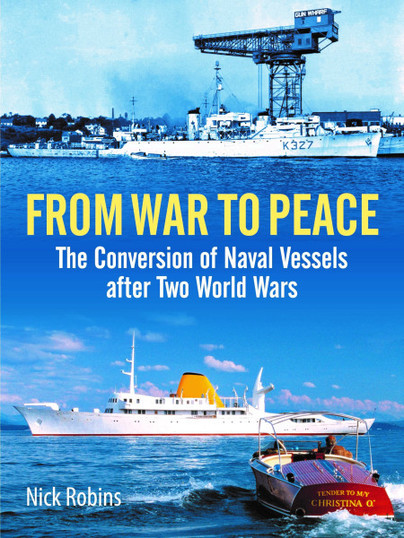
From War to Peace: The Conversion of Naval Vessels after Two World Wars. By Nick Robins. Published by Seaforth Publishing, Barnsley, Yorkshire, 2021. Hardcover, 176 pages, index. ISBN 978 1 3990 0958 4
Reviewed by Mark Bailey PhD
This well-illustrated book is typical of Seaforth publications; the book is of high quality in all respects, crisply and clearly printed on high quality stock, well bound and with clear, high quality black-and-white photographs in profusion. From War to Peace is an unusual book which casts light into one of the little explored areas of naval history, the conversion of large numbers of naval vessels to civil use after the wars ended.
The book discusses many examples but focusses on Royal Navy vessels, including ships sourced from the United States under Lend-Lease. Because of the nature of the Empire’s Navies a number of their vessels are also discussed.
Aside from some classes of trawlers and tugs, which were commercial designs minimally adapted to wartime use so as to fully exploit commercial production capacity, commercial use was not a design factor for warships. This was especially true in wartime programs. That said, some classes proved to be surprisingly successful in post-war commercial roles. These included the Hunt-class minesweepers and X-lighters of WWI, and from WWII various landing craft up to and including LST, frigates, purpose-designed heavy salvage tugs and numerous small motorcraft such as the Fairmile type launches. These became familiar to the public, being used for river, estuarine and coastal day-trips up until the 1960s. As in WWI, the war-built trawler types such as the MFV classes found ready homes in the fishing industry.
What makes the book so interesting is the unusual. Chapter 6 has a brief but fascinating coverage of some larger German ships after WWI, and pp.58-59 has a very interesting image of the former coast-defence ship Frithjof in commercial guise. The coverage of post-WWI commercial conversions of M and FM class minesweepers indicates that the post-WWII conversions of ex-RN escorts into car and passenger ferries had ample precedent.
There are some noteworthy errors. An example is the 1920 conversion of an incomplete S&T class destroyer into the steam yacht Cutty Sark by Major Henry Keswick. This is incorrectly described as a V&W conversion, yet does not detract from the value of the book. She was not the only yacht conversion of course, the 1954 conversion of the Canadian River Class frigate HMCS Stormont to the luxury yacht Christina O for the Greek shipping magnate Aristotle Onassis is another example, and the ship is still in service. The coverage of successful commercial conversions of many escorts including Flower and Castle Class corvettes and various frigates is the subject of Chapter 7.
Better-known conversion of some larger ships such as escort carriers and HMS (formerly HMAS) Albatross is also covered. A strength of the book is the vignettes of so many of the ships. This ranges from the relatively well-known story of how Albatross almost became a luxury liner, but wound up being a notoriously unpopular emigrant ship to the remarkably long commercial life of the obscure WWI lighter X-44.
The author asks and answers an interesting question: what was the effect of converting so many warships to commercial operations on mercantile technological development? The answer is a surprising one: the conversions had a significant impact especially on proving new commercial concepts. It was converted naval vessels that promoted the early development of the Ro-Ro ferry concept and many other post-war commercial innovations. The former naval ships introduced concepts and technologies (themselves the result of accelerated wartime development in specialised areas) at low cost, and enabled more experimentation that would otherwise have occurred.
Nick Robins has done something unusual and fresh with this book. The book is most certainly about naval vessels, but with a really interesting twist. As a result, it is a refreshing and intriguing book to read. Recommended for ANI members.



